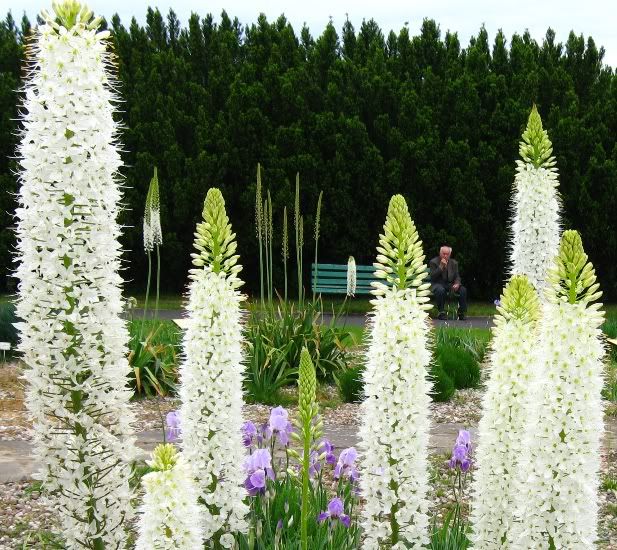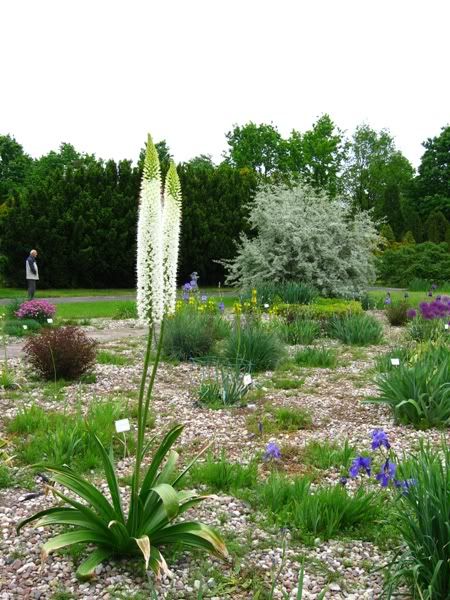Showy and extremely eye-catching. What a beauty... Don't you think?
When I saw it last year, late May in a Botanic Garden in Powsin/Poland I stopped and was staring at it for few minutes.
White flowers 1"/2.5cm long, appear on a spike, growing up to 2 meters - as this one on the picture. This Eremurus was discovered 1881 in Kashmir/Himalaya.
It grows well in a sunny, well drained spot - there shouldn't be any shade on the spot where they grow. Present best on dark background.
Eremurus Himalaicus - is one of the earliest flowering Eremurus - flowers appear in May/June. On the left side of the picture you can see later kind of Eremurus that prepare to flower.
On the picture above you can see the proportions. Look how small are irises, which were regular size, not any kind of miniatures.
Recommended further reading The Well-Tended Perennial Garden: Planting and Pruning Techniques
How to plant Eremurus?
Roots - plant dormant roots in the autumn 6"/15cm deep, make the hole large enough, so you can spread the root radiate evenly, no crowding - the central bud should be not deeper than 2-3"/5-7cm below the soil level.
Care
Most important for succes with Eremurus himalaicus is spacing (30 cm), light and sunny-hot-well-drained soil. After flowering they should be kept dry. Slugs like it, so your Eremurus will need also some care against.
Propagation
Roots - division of roots in the spring or early fall.
Seeds - need stratification (period of time when they are exposed to temperature below 0C), so sow them in the fall for that reason. If you know that they went through stratification sow them in spring when temperature reaches 55-60F/13-15C, slightly cover, Eremurus seeds
need light to germinate.
need light to germinate.
Hardiness
Can be hardy to zone 3 if protected in winter, however their hardiness is considered up to zone 5.Roots may be stored indoors cool and dry and planted again in spring.
Eremurus is considered as not easy to grow plant. Maybe you have some experience to share?
Related reading The Well-Tended Perennial Garden: Planting and Pruning Techniques
Related reading The Well-Tended Perennial Garden: Planting and Pruning Techniques






7 comments:
Absolutely gorgeous photos - I LOVED THEM. I want these flowers and wonder how they would grow in the Chicago area. Thanks for showing them!
Shawna Coronado
http://thecasualgardener.blogspot.com
They're lovely. I've never seen them before. Thanks for showing us!
Lovely, Ewa. I have often thought about growing some of these plants, but never did. Now, I know I need to get a few for my garden. Thanks for the views.
Jan
Always Growing
Those are beautiful! I can't believe how big they are!
My mom and I both tried to grow them a couple of years ago and neither of us had them make it through the winter here in zone 5. We bought them at the same time and they were very healthy roots. Mom's grew the first year she planted them, but didn't bloom. Mine didn't even grow. :-(
They are quite stunning though, aren't they?
Seed stratification: Seed must be subjected to temperatures ABOVE freezing (34oF - 40oF)AND moisture. Merely sticking dry seed in the refrigerator will not satisfy stratification requirements.
Fab flowers saw them for the 1st time yesterday in a garden as i was passing now going to look in garden centres for them
Post a Comment